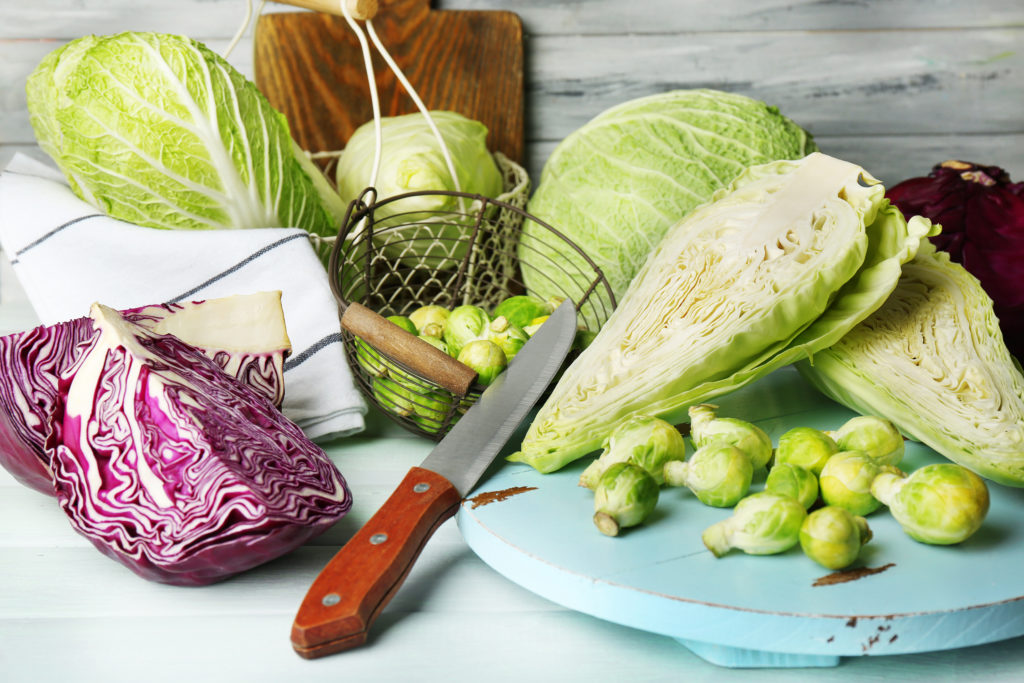Blog
Functional Food Super Hero #1 – Cabbage
 This is the first in our 10 part series of foods that are accessible, affordable, and pack a nutritional punch, whilst easy to incorporate into our every day.
This is the first in our 10 part series of foods that are accessible, affordable, and pack a nutritional punch, whilst easy to incorporate into our every day.
With many, the thought of cabbage conjures thoughts of not-so-pretty smelling rear end tooting. What we need to keep in mind is that smell can actually be a good sign. Within cabbage, and other brassica vegetables such as kale, broccoli, bok choy, and radish is a phytoconstituent called sulforaphane. This compound contains sulfur, and alongside its antioxidant and anti-inflammatory properties, it can contribute to the smelliness when passing wind – but our gut microbes LOVE foods like cabbage. LOVE them!
The phytoconstituent magic
Cabbage, like its brassica siblings, plays an important role in estrogen metabolism. This is due to the glucosinolate called indole-3-carbinol, which assists to clear excess estrogen in the body, whilst inhibiting the activity of the type of estrogen (as there are several) linked with cancerous cell proliferation in the breast and uterus. (1,2,5,6,8) This may positively impact premenstrual syndrome (PMS) and estrogen fed cancers such as breast cancer.
As mentioned, constituents within cabbage also undertake anti-inflammatory and antioxidant activity, and include the carotenoids lutein and zeaxanthin, which have been found to support eye health by possibly preventing age-related macular degeneration and cataracts, and possibly boost cognitive health. (3)
Fibre fibre fibre
For many years we have been encouraged to keep up the fibre intake, getting a dose of bran or Metamucil to keep bowels moving. There is good reason for this, yet we still seem to lack the adequate intake (9) of 25grams per day for females, and 30 grams per day for males. (7)
Increased fibre intake has been associated with decreased risk of diverticular disease and colon cancer, reduced obesity in adolescents, and cardiovascular disease, as well as having an array of other health benefits. (3)
And this is aside from feeding the good gut microbes! There is a raft of positive ramifications when the helpful microbes are on top form, impacting mood, immunity, and even heart health! That is a topic for another conversation, lets get back to cabbage!
The colour red
There are several varieties of cabbage, and the type that offers a big bang for its buck is red (or purple) cabbage. Not only does it look amazing in salads, soups or alongside some braised meat, it is packed full of anti-oxidants.
In fact, when compared for antioxidant value, purple cabbage has been seen to have nearly as twice as much antioxidant activity as oranges, and a similar amount to goji berries. (10) Acai berries are known as an antioxidant king, yet red cabbage is less than half the price than acai berry powder, and whilst you have to eat a lot more cabbage, you will also get heaps of fibre to keep you fuller for longer!
Ideas to incorporate
Here are some delicious ways to incorporate cabbage into your every day:
- The Salad Jar
- Braised with apples and walnuts, or with apples and bacon
- Thai or Japanese style salads
- Added to soups last minute, thinly sliced
- Incorporated into potato hash, or an omelette
- Pickled or fermented
- Lightly stir fried, and it can be used as an alternative to noodles
- Use as a wrap alternative with Asian or Mexican fillings typical of rice paper rolls or burritos
References
- Ashok BT, Chen Y, Liu X, Bradlow HL, Mittelman A, Tiwari RK. Abrogation of estrogen-mediated cellular and biochemical effects by indole-3-carbinol. Nutr Cancer. 2001;41(1-2):180-187
- Bradlow HL, Telang NT, Sepkovic DW, Osborne MP. 2-Hydroxyestrone: the ‘good’ estrogen. J Endocrinol. 1996;150 Suppl:S259-265
- Brauchla, M, Juan, W, Story, J, & Kranz, S 2012, ‘Sources of dietary fiber and the association of fiber intake with childhood obesity risk (in 2-18 year olds) and diabetes risk of adolescents 12-18 year olds: NHANES 2003-2006’, Journal of Nutrition and Metabolism.
- Johnson, EJ 2014, ‘Role of lutein and zeaxanthin in visual and cognitive function throughout the lifespan’, Nutrition Reviews, vol. 72, no. 9, pp. 605-612
- Licznerska, B, Szaefer, H, Murias, M, Bartoszek, A, & Baer-Dubowska, W 2013, ‘Modulation of CYP19 expression by cabbage juices and their active components: indole-3-carbinol and 3,3′-diindolylmethene in human breast epithelial cell lines’, European Journal of Nutrition, vol. 52, no. 5, pp. 1483-1492 10p
- Meng Q, Yuan F, Goldberg ID, Rosen EM, Auborn K, Fan S. Indole-3-carbinol is a negative regulator of estrogen receptor-alpha signaling in human tumor cells. J Nutr. 2000;130(12):2927-2931.
- Nutrient Reference Values 2014, Dietary Fibre, National Health and Medical Research Council, Australian Government and Ministry of Health, New Zealand Government, viewed February 2016.
- Rahman, K, Li, Y, & Sarkar, F 2004, ‘Inactivation of Akt and NF-kappaB play important roles during indole-3-carbinol-induced apoptosis in breast cancer cells’, Nutrition & Cancer, vol. 48, no. 1, pp. 84-94 11p
- State Government of Victoria 2015, Fibre in Food, Better Health Channel, viewed February 2016, <https://www.betterhealth.vic.gov.au/health/healthyliving/fibre-in-food>
- S. Department of Agriculture, Agricultural Research Service 2010, Oxygen Radical Absorbance Capacity (ORAC) of Selected Foods, Release 2, Nutrient Data Laboratory Home Page: http://www.ars.usda.gov/nutrientdata/orac











